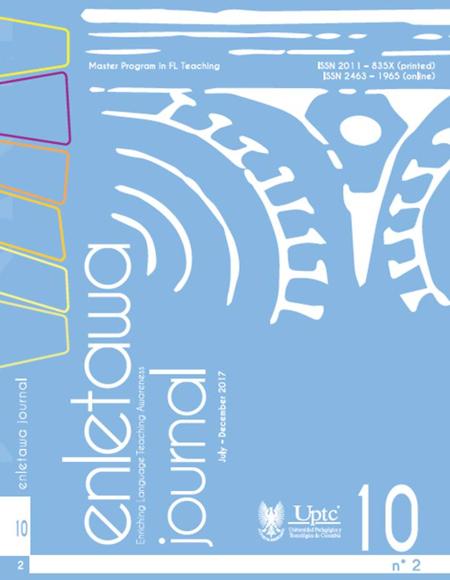Escritura de historias cortas para describir el uso del lenguaje literario y las percepciones como escritor

Resumen
Este estudio de caso cualitativo busca describir el proceso que estudiantes de noveno grado de un colegio privado religioso siguieron cuando escribieron sus historias cortas a través del uso y del análisis del lenguaje literario. Los instrumentos usados para llevar a cabo este estudio fueron: las producciones escritas de los estudiantes para identificar y analizar el lenguaje literario usado, notas de campo y entrevistas. En este proceso, los estudiantes como autores, generaron la construcción de significado y desarrollaron la competencia escritora. Los resultados muestran que los estudiantes usaron metáforas y símiles (elementos literarios) para expresar ideas y detalles acerca de sus contextos en la producción escrita, beneficiándose de la función poética del lenguaje donde sus voces
como autores describen sus percepciones y sus experiencias como escritores.
Palabras clave
Competencia en escritura, lenguaje literario, percepción como escritores, historia corta
Citas
Anderson, A., and Jones, N. (1986). TAFE curriculum research: A review of group process methods. Adelaide: TAFE National Centre for Research and Development.
Bakhtin, M. (1981). The dialogic imagination (M. Holquist Ed.). Austin, TX: University of Texas Press.
Barton, D., and Hamilton, M. (2000). Literacy practices. In D. Barton, M. Hamilton, & R. Ivanovic (Eds.), Situated Literacies. Reading and Writing in Contexts (pp 7-15) London Routledge.
Bottomley, D. (1998). Assessing children’s views about themselves as writers using the Writer Self-Perception Scale. The Reading Teacher, 51(4), 286-296.
Butler, A., and Turbill, J. (1984). Towards a reading writing classroom. Portsmouth, NH: Heinemann.
Cassany, D. (1995). Describir el escribir, como se aprende a escribir. Barcelona: Paidos Iberica.
Dinneen, K., and O’Connor, M. (1983). Elements of the Short Story. Retrieved from: http://www.yale.edu/ynhti/curriculum/units/1983/3/83.03.09.x.html
Eco, U. (1981). Lector in fábula, la palabra en el tiempo. Barcelona: Lumen.
Eco, U. (1992). Interpretación y sobreinterpretacion de textos. Cambridge: Cambridge University Press.
Fokkema, D. (1985). The Concept of Code in the Study of Literature. Poetics Today, 6(4), 643-656
Freire, P. (1998). Pedagogy of freedom: Ethics, democracy, and civic courage (Clarke, P., Trans.). Maryland: Rowman & Littlefield.
Gee, J. P. (1991). What is literacy? Toronto: OISE Press.
Genette, G. (1989). Figuras III. Barcelona: Lumen.
Greenberg, K. (1987). Defining, teaching, and testing basic writing competence. Topics in Language Disorders, 7(4), 31-41.
Hemingway, E. (1987). The complete short stories of Ernest Hemingway. Finca Vigía Edition. New York: Scribner.
Hernández, R., Fernández, C., and Baptista, P. (2006). Metodología de la investigación (4th ed.). México: Mc Graw Hill.
Hicks, D. (1996). Contextual inquiries: A discourse-oriented study of classroom learning. Cambridge, MA: Cambridge University Press.
Hopkins, D. (1995). A Teacher’s Guide to Classroom Research. Buckingham, PA: Philadelphia Open University Press.
Hubbard, R., and Miller (1999). Living the questions: A guide for teachers-researchers. Maine: Stenhouse.
Jeffrey, B., and Craft, A. (2004) Creative practice and practice which fosters creativity in L. Miller and J. Devereux (Eds.) Supporting children’s learning in the early years (105-112). London: David Fulton.
Kennedy, J., and Gioia, G. (1999). Literature: An introduction to fiction, poetry, and drama. Ed. Harcourt.
Lazar, G. (1993). Literature and language teaching. Cambridge: Cambridge University press.
Liu, Y. (2009). The significance of structure in analyzing short stories. Asian Social Science Journal, 5 (8), 141-143
Merriam, S. (1985). The case study in educational research: A review of selected literature. Journal of Educational Thought, 19 (3), 204-217.
Miller, C. (1989). Writing Competency Statements in Communication. Edinburgh: Napier Polytechnic.
Mischler, E. G. (1986). Research interviewing. Context and narrative. Cambridge, MA: Harvard University Press.
Newton, J. (2001). Options for vocabulary learning through communication tasks. ELT Journal, 55 (1), 30-37.
O’Donoghue, B. (2001). What is literary language? (Why some words are more literary than others). A critical essay. The English Review, 4 (11) 28.
Osgood, C. (2005). The Measurement of Meaning. Urbana, IL: University of Illinois Press.
Pawlas, G.E. (1995). The structured interview: Three dozen questions to ask prospective teachers. NASSP Bulletin,79, 62-65.
Pennycook, A. (1989). The concept of method, interested knowledge, and the politics of language teaching. TESOL Quarterly, 23 (4), 589 – 618.
Poe, E. A. (1993). Tales of Mystery and Imagination (2nd ed.). Retold by Margaret Naudi. Oxford University Press: New York.
Quintero, N., Cortondo, P., Menéndez, T., and Posada, F. (1995). A la hora de leer y escribir…textos. Argentina: AIQUE.
Quiroga-Clare, C. (2003). Language ambiguity: A curse and a blessing. Translation Journal. 7(1), 57-61.
Recanati, F. (2001). Literal/Nonliteral. Midwest Studies in Philosophy, 25, 264- 274.
Sharples, M. (1996). An account of writing as creative design. Hillsdale, NJ: Lawrence Erlbaum
Tambling, J. (1988). What Is literary language? Michigan: Open University Press.
White, R., and Arndt, V. (1991). Process writing. London: Longman.
Wilde, O. (1981). The nightingale and the rose. London: Kaye & Ward.
Yin, R. (1989) Case Study Research: Design and Methods (rev. ed.). Beverly Hills, CA: Sage Publications.
Zonabend, F. (1992). The monograph in European ethnology. Current Sociology, 40 (1), 49-60.